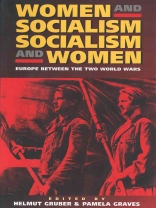Until recently, histories of women tended to be segregated from the larger historical context. This pioneering volume places the role of women within the history of the interwar years, whenboth the women’s and socialist movements became prominent, and raises the key question of how power was distributed between the genders in a historical setting. The emblematic title of this volume highlights the fundamental conception of this comparative study of eleven West European countries: that in the interwar decades two great movements gained in strength, converged, diverged, competed, and cooperated. Each of these movements is viewed as acomplex matrix of organized and unorganized participants. However, by far the most provocative questions deal with gender relations. Central to these are definitions of femininity and masculinity in terms of mechanisms of inclusion and exclusion at the workplace, in the home, and in the political arena. The mystique of the ‘new woman’ in the 1920s and the 1930s challenged traditional notions of gender identity and relations, not the least of which was the redefinition of the role of men. The main issue addressed in this volume is not how male socialists ‘dealt with’ the woman question or how women functioned in or outside left-wingparties; it rather centers on illustrating the power distribution between the sexes in specific political and cultural contexts. This rigorously focused and coherent volume, to which some of the best-known scholars in the field have contributed, will no doubt establish itself as the standard reference work for years to come.
Содержание
List of Photo Essays
List of Acronyms
Acknowledgments
Introduction
Helmut Gruber & Pamela Graves
1914: Great Feminist Expectations
Michelle Perrot
PART I: SOCIAL EXPERIMENTS
Introduction
Atina Grossmann
Chapter 1. ‘The “New Woman”: Realities and Illusions of Gender Equality in Red Vienna
Helmut Gruber
Chapter 2. Modernization as Challenge: Perceptions and Reactions of German Social Democratic Women
Adelheid von Saldern
Chapter 3. German Communism and New Women: Dilemmas and Contradictions
Atina Grossmann
PART II: GRASSROOTS INITIATIVES
Introduction
Pamela Graves
Chapter 4. An Experiment in Women-Centered Socialism: Labour Women in Britain
Pamela Graves
Chapter 5. Gender and Democratic Socialism in the Netherlands
Ulla Jansz
Chapter 6. Bread and Roses: Pragmatic Women in the Belgium Workers’ Party
Denise De Weerdt
PART III: POLITICAL FRACTURES
Introduction
Mary Gibson
Chapter 7. French Women in the Crossfire of Class, Sex, Maternity and Citizenship
Helmut Gruber
Chapter 8. The French Communist Party and Women 1920-1939: From “Feminism” to Familialism
Christine Bard & Jean-Louis Robert
Chapter 9. ‘Ideals of Redemption”: Socialism and Women on the Left in Spain
Mary Nash
Chapter 10. Women and the Left in the Shadow of Fascism in Interwar Italy
Mary Gibson
PART IV: PRELUDE TO WELFARE STATES
Introduction
Ida Blom
Chapter 11. Social Democrats and the Woman Question in Sweden: A History of Contradiction
Renée Frangeur
Chapter 12. A Double Responsibility: Women, Men, and Socialism in Norway
Ida Blom
Chapter 13. Socialist Feminists and Feminist Socialists in Denmark 1920-1940
Hilda Romer Christensen
PART V: REFLECTIONS
Chapter 14. Women, Citizenship, and Power
Louise A. Tilly
Chapter 15. From Welfare Politics to Welfare States: Women and the Socialist Question
Geoff Eley
List of Contributors
Indexes
Name Index
Subject Index
Subject Index by Country
- Austria
- Belgium
- Britain
- Denmark
- France
- Germany
- Italy
- The Netherlands
- Norway
- Spain
- Sweden
Об авторе
Helmut Gruber is Charles S. Baylis Professor of History emeritus, Polytechnic University, New York, and co-editor of International Labor & Working-Class History.












